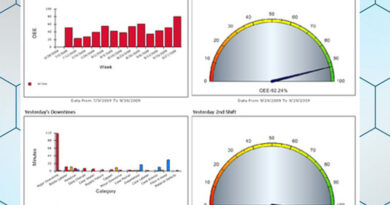Vibration Analysis Explained
Vibration analysis helps you monitor and detect issues using vibration data. Read about vibration analysis methodology, tools and techniques, vibration analysis measurement methods, and more.
What Is Vibration Analysis?
Vibration analysis is defined as a process for measuring the vibration levels and frequencies of machinery and then using that information to analyze how healthy the machines and their components are. While the inner-workings and formulas used to calculate various forms of vibration can get complicated, it all starts with using an accelerometer to measure vibration. Anytime a piece of machinery is running, it is making vibrations. An accelerometer attached to the machine generates a voltage signal that corresponds to the amount of vibration and the frequency of vibration the machine is producing, usually how many times per second or minute the vibration occurs.
All data collected from the accelerometer goes directly into a data collector (software), which records the signal as either amplitude vs. time (known as time waveform), amplitude vs. frequency (known as fast Fourier transform), or both. All of this data is analyzed by computer program algorithms, which in turn is analyzed by engineers or trained vibration analysts to determine the health of the machine and identify possible impending problems like looseness, unbalance, misalignment, lubrication issues and more. Vibration analysis can detect problems such as:
- Imbalance
- Bearing failures
- Mechanical looseness
- Misalignment
- Resonance and natural frequencies
- Electrical motor faults
- Bent shafts
- Gearbox failures
- Empty space or bubbles (cavitation) in pumps
- Critical speeds
Distributor and alignment and maintenance training provider VibrAlign uses the example of taking an industrial fan, removing a fan blade and starting it up. As expected, the fan vibrates due to an unbalanced fan wheel. This unbalanced force will occur one time per revolution of the fan. Another example would be a damaged bearing track causing a bearing roller to generate vibration each time it contacts the spall (similar to a pothole on a highway). If three bearing rollers hit the spall per revolution, you should see a vibration signal of three times the fan’s running speed.
Vibration Analysis Methodology
While accelerometers are still the most common tool used to collect vibration data, modern technology and improved sensor technology have allowed for non-contact, high-speed laser sensors that can detect issues accelerometers can’t. This allows for a more accurate and more localized analysis, and opens up vibration analysis to more methodology. Vibration analysis is generally broken down into four principles, and each principle gives you specific information on the working conditions and features of the vibrating parts.
- Time domain: When a vibration signal is picked up from a transducer (device that converts a physical quantity into an electrical signal) and displayed on the screen of an oscilloscope, it’s called a waveform. This signal is in the time domain. The time domain is amplitude plotted against time. While most machine vibration issues are detected using spectrum analysis, some types are more easily seen in waveform.
- Frequency domain: When the waveform discussed earlier is subjected to spectrum analysis, the end result is a picture of frequency vs. amplitude, known as a spectrum. The spectrum is in the frequency domain like the vibration is in the time domain. Most in-depth analysis of machinery vibration is done in the frequency domain or using spectrum analysis.
- Joint domain: Because vibration signals vary with time, calculating more than one spectrum at once can be useful. To do this, a joint time technique called Gabor-Wigner-Wavelet can be utilized. This technique is used to calculate variations of the fast Fourier transform (discussed below), including short-time Fourier transform (STFT).
- Modal analysis: Modal analysis takes measured frequency response functions of a piece of machinery and puts them into a computer model. The computer model can be displayed with animations of all the different vibration modes. The model can be adjusted by either adding to or taking away things like mass or stiffness to see the effects.
Outside of these four basic principles lie numerous forms of analysis, calculations and algorithms used to determine different aspects of vibration analysis. These include:
-
- Time waveform: A time waveform is acceleration vs. time displayed as tables and plots. Time waveforms show a short time sample of raw vibration, revealing clues to the condition of machinery not always clear in the frequency spectrum. A method of employing time waveform vibration signals as a vibration analysis tool is by using FFT.

-
- Fast Fourier Transform (FFT): FFT is defined as an algorithm used to calculate a spectrum from a time waveform. In other words, it’s a calculation intended to break down a signal into all its frequencies. If you’ll recall time domain and frequency domain discussed above, FFT converts a signal from the time domain into the frequency domain. Fast Fourier transform is most often used for detecting machine faults like misalignment or unbalance.
- Phase measurement: When talking about vibration analysis, phase is a relative time difference between two signals measured in units of angle as opposed to time. It only works if the two signals being compared are of the same frequency. Phase measurement is used in tandem with FFT to decipher machine faults like loose parts, misalignment and unbalance.
- Order analysis: Order analysis is a variation of FFT analysis and is mostly used to quantify vibrations of machines with varying revolutions per minute (RPM). In other words, order analysis is frequency analysis where the spectrum’s frequency axis is shown in orders of RPM rather than hertz. The term “orders” refers to a frequency that is a multiple of a reference rotational speed. For example, if a vibration signal is equal to twice the frequency of the motor’s rotation, the order is two.
- Power spectral density (PSD): Power spectral density is calculated by multiplying the amplitude from the FFT by its different forms to normalize it with the frequency bin width (bin width refers to the grouped x-axis values). Think of PSD as looking at “random” vibrations or motion at many different frequencies. PSD accurately compares random vibration signals that have different signal lengths.

- Envelope analysis: Envelope analysis is a form of vibration analysis that can detect impacts with very low energy often hidden by other vibration signals. It’s a popular diagnostic tool for damaged gear teeth and roller bearings.
- Orbit: The orbit is defined as a plot of a sleeve bearing journal’s centerline. It’s measured by placing two probes in the bearing housing 90 degrees apart. Data from these probes can be displayed digitally and used to detect shaft vibrations caused by oil whirl – oil whirling around inside, causing the journal to move.
- Resonance analysis: Resonance analysis identifies all the natural vibrations and frequencies in machines. The presence of resonance means high vibration, which could reach damaging levels.
Categories of Vibration Measurement
- Overall level of vibration: You can think of checking the overall level of vibration like a “rough check” on a machine. By feeling a machine with your hand, you can determine a general sense of whether it is running roughly over a wide frequency band. This initial check is best on rotating machinery, in particular high-speed machines. It’s not usually applicable to reciprocating machines.
- Spectral analysis of vibration: Spectral analysis is the process of transforming a signal from the time domain to the frequency domain. It’s often done using FFT. The signal is analyzed to determine any substantial frequencies coming from the machine’s components. Where there is a peak in frequency signal, that is the likely source of vibration. Common applications for spectral analysis include the rotational speed of a shaft or how often tooth meshing occurs on a pair of gear wheels.
- Discrete frequency monitoring: If you need to monitor a specific component within a machine, discrete frequency monitoring measures the vibration level being generated at a particular frequency which that component would be expected to generate. For example, if you want to look into a certain shaft in a machine, you would turn the monitoring to that machine’s rotational speed. Discrete frequency is calculated using the FFT algorithm.
- Shock pulse monitoring: Shock pulse monitoring is a predictive maintenance technique that monitors rolling-element bearings with a hand-held instrument. The hand-held instrument gives off a natural frequency that is excited by shocks or vibrations generated by rolling bearings. In other words, when two pieces of metal touch each other while in motion, shock waves develop from the impact, which travels through the metal. This shockwave is used in shock pulse monitoring.
- Kurtosis measurement: Kurtosis gives you a measure of the “spikedness” of a random signal. Signals with a higher kurtosis value have more peaks that are greater than three times the signal’s root mean square (RMS) value. In vibration analysis, kurtosis is used to monitor fatigue development in rolling bearings with a simple instrument.
- Signal averaging: Since signals change with time, signal averaging is important in spectrum analysis because it determines the level of the signal at each frequency. It’s particularly important for low-frequency measurements because they need a longer averaging time to get a statically accurate estimate of the spectrum. Signal averaging is often used in the monitoring of a gear in relation to its rotational speed. In this example, signal averaging will show you the cyclic action of each tooth in the gear. If a tooth has a large crack, it would be detected due to its increased flexibility.
- Cepstrum analysis: Originally invented to characterize seismic echoes produced by earthquakes and bomb explosions, cepstrum is used to look at the repeated patterns in a spectrum. Repeated patterns in the spectrum are sensed as one or two components in the cepstrum with multiple sets of sidebands, which can be confusing. The cepstrum separates those sidebands like the way the spectrum separates repetitive time patterns in the waveform. Cepstrum analysis is often utilized to look at interactions between the rotational frequency of bladed rotors and the blade passing frequency. Another example is examining gear tooth meshing frequencies and gear rotational speeds.
Vibration Analysis Measurement Parameters
All of these vibration analysis techniques help to identify three major parameters: acceleration, velocity (RMS) and displacement. Each of these parameters emphasizes certain frequency ranges in their own way and can be analyzed together to diagnose issues. Let’s take a look at each parameter.
- Acceleration: Acceleration places greater importance on high frequencies. An acceleration signal is not exclusive, however. The acceleration signal can be converted to velocity or displacement.
- Displacement: Just like acceleration places greater importance on high frequencies, displacement looks at low frequencies. Displacement measurements are generally only used when examining the broad picture of mechanical vibrations. You might use displacement to discover unbalance in a rotating part due to a significant amount of displacement at the rotational frequencies of the machine’s shaft.
- Velocity: Velocity is related to the destructive force of vibration, making it the most important parameter. It places equal importance on both high and low frequencies. Usually, the RMS value of velocity (measured in the range of 10 to 10,000 Hz) shows the best sign of vibration severity. RMS is calculated by multiplying peak amplitude by 0.707.
Below is an example of what acceleration, displacement and velocity look like on the same signal. You can see some peaks at the same frequencies, but each has different amplitudes. This is a good visual of how each parameter assigns different importance to frequency ranges.

Vibration Analysis Tools and Technology
Advanced technology, particularly advances in wireless technology, has greatly improved how vibration analysts collect, interpret and share data. Today, vibration analyzers are extremely portable, communicate with smartphones and tablets in real time, and can generate FFT in extremely high resolution. Many vibration instrument companies develop their own apps to communicate with each other.
Another form of advanced technology you’ll see with vibration analysis interpretation instruments is operating deflection shapes (ODS) 3D simulations of machinery vibrations. In a nutshell, this type of software exaggerates vibration-induced movements in a 3D model so you can visualize the forces impacting your machine while it’s running.
Some vibration analysis instrument companies offer databases with thousands of bearing fault frequencies preloaded to help you identify certain fault frequencies for your bearings. Some software can continuously monitor the geometry of your rolling elements and warn you when possible premature failures may occur.
As with most advanced technology, the majority of vibration analysis data is automatically uploaded to the cloud and is available on your mobile device, computer or directly from your browser. This is especially useful if you’re performing vibration analysis as a third-party consultant, so you can freely share spectra with your clients.
Benefits of Continuous Vibration Monitoring
The methods and tools discussed in this article not only are great for determining what’s wrong with a piece of equipment or machinery (reactive), but they also can be used to catch issues before they cause significant downtime (proactive). Using vibration analysis and monitoring enables you to look quantitatively into structural weakness or looseness, rotating component looseness and whether resonance is present.
If implemented properly, continuous vibration monitoring helps you optimize machinery performance. With the use of modern technology, you can take continuous vibration readings on various equipment in real time and have the data sent directly to your smartphone, tablet or desktop via the cloud.
- Monitor critical equipment: Critical equipment is any piece of equipment or machine that could cause you to take a big financial hit if a failure were to occur. Continuous vibration monitoring helps detect discrepancies in the vibration spectrum, which can reveal lubrication issues and bearing defects well before major issues appear.
- Monitor heavily used equipment: Many plants operate 24/7, only stopping monthly or quarterly for routine maintenance. Stopping more than this can cost the plant a significant amount of money. Online continuous vibration monitoring helps monitor the condition of heavily used machinery or troubled machinery and sends alerts when that condition changes.
- Monitor difficult-to-access equipment: Performing maintenance on equipment located in hard-to-reach places is difficult. Machines on rooftops, cooling towers and those operating in high-temperature areas can be continuously monitored for vibration abnormalities, allowing maintenance to be done at a convenient time. This prevents unplanned downtime and keeps maintenance staff from accessing these locations unnecessarily.
Vibration Analysis Case Study
The tools and techniques used in the vibration analysis process can be a bit confusing on paper, so let’s take a look at a real-world example from IVC Technologies. This particular case study examines the testing of an air-handling unit in a pharmaceutical facility. The unit is needed to run two supply fans at capacity to meet enclosed air-flow requirements. The air-handling unit has two direct-coupled fans, each equipped with a 150-horspower motor. The initial assessment of the fan unit showed the unit to run normally when one fan was running, but once the second fan was turned on, vibration issues presented themselves at certain set points.
Vibration analysis revealed that once fan No. 2 was turned on, a slight increase in vibration amplitude across all three points of measurement occurred, while fan No. 1 remained the same. Testing showed the highest amplitude appeared in the motor outboard vertical at 0.456 inches per second, with a dominant peak at 841 cycles per minute, according to IVC Technologies. This indicated the problem might be a structural resonance vibration, since spectral data showed no other signs of mechanical issues.
| Measurement Point | VFD Speed | Fan #2 | Fan #1 |
|---|---|---|---|
| Motor Outboard Vertical (MOV) | 55.6 Hz | 0.456 In./Sec. | 0.255 In./Sec. |
| Motor Inboard Vertical (MIV) | 55.6 Hz | 0.347 In./Sec. | 0.174 In./Sec. |
| Motor Inboard Horizontal (MIH) | 55.6 Hz | 0.260 In./Sec. | 0.96 In./Sec. |
*Information from IVC Technologies Air Handling Unit Case Study
As the consultant, IVC Technologies recommended the company inspect the frame’s structure and the dynamic absorber of fan No. 2. A bump test was also recommended to further locate and analyze the resonance vibration.
By: Jonathan Trout,




